Ficus elastica (‘Robusta’) is a stunning plant with large, glossy leaves that boast a deep green color, adding a touch of elegance to any space. The leaves are thick and leathery, giving them a distinct and attractive texture. The foliage of the rubber tree is also known for its shiny appearance, which reflects light beautifully.
Key Takeaways:
- Ensure your Ficus elastica (‘Robusta’) receives six to eight hours of bright indirect light daily.
- Water your rubber plant every 1-2 weeks, allowing the soil to dry out between waterings.
- The rubber tree can tolerate any level of humidity.
- Maintain a temperature range of 65°F to 85°F for optimal growth.
- Repot your Ficus elastica (‘Robusta’) in the spring if the roots outgrow the pot.
Why Choose Ficus elastica (‘Robusta’)?



When it comes to indoor plants that make a statement, few can rival the beauty and resilience of Ficus elastica (‘Robusta’). This stunning variety of the rubber tree family is known for its large, glossy leaves that add a touch of tropical elegance to any space.
Whether you’re a seasoned plant enthusiast or just starting your green thumb journey, Ficus elastica (‘Robusta’) is an excellent choice for a variety of reasons.
First and foremost, Ficus elastica (‘Robusta’) is incredibly easy to care for, making it an ideal plant for beginners. It can tolerate a wide range of light conditions, although it thrives in bright indirect light. This means you can place it in a variety of locations within your home or office and still enjoy its vibrant presence.
Additionally, the rubber tree can withstand fluctuations in temperature, making it adaptable to different climates. Another reason to choose Ficus elastica (‘Robusta’) is its ability to purify the air. Like other members of the Ficus elastica family, this plant is known for its air-purifying qualities.
It absorbs toxins such as formaldehyde, benzene, and trichloroethylene, helping to create a healthier living environment for you and your family. Additionally, Ficus elastica (‘Robusta’) has been found to increase humidity levels, which can benefit those living in dry climates or during the winter months.
Enhancing Your Space with Ficus elastica (‘Robusta’)
Aside from its air-purifying properties, Ficus elastica (‘Robusta’) also adds a touch of natural beauty and elegance to any space. Its large, glossy leaves create a lush and vibrant atmosphere, instantly transforming a room into a tropical oasis.
You can showcase the rubber tree as a focal point in your living room, office, or even the entrance hallway. Its stunning foliage will undoubtedly be a conversation starter and a visual delight for anyone who walks by.
| Ficus elastica (‘Robusta’) Care Best Practices | Ficus elastica Care Instructions |
|---|---|
| Provide bright indirect light | Water every 1-2 weeks, allowing soil to dry out between waterings |
| Maintain a temperature range of 65°F to 85°F | Protect from pests and wipe the leaves clean |
| Repot in spring when roots outgrow the pot | Fertilize with liquid fertilizer once a month in spring and summer |
Appearance of Ficus elastica (‘Robusta’)

The size of Ficus elastica (‘Robusta’) leaves can vary, with some reaching lengths of up to 12 inches. The leaves are typically elliptical in shape, with prominent veins running through them. This unique leaf structure adds visual interest and makes Ficus elastica (‘Robusta’) a popular choice among plant enthusiasts.
When it comes to overall height, Ficus elastica (‘Robusta’) can grow to impressive proportions. Outdoors, it can reach heights of about 30 feet, while indoors, it usually stays more manageable, ranging from 6 to 10 feet. This versatility in size makes it suitable for a wide range of indoor spaces, from small apartments to larger homes or offices.
| Common Name | Scientific Name | Watering | Light Requirements | Temperature | Humidity | Pet Safety |
|---|---|---|---|---|---|---|
| Rubber Tree | Ficus elastica (‘Robusta’) | Every 1-2 weeks | 6-8 hours of bright indirect light | 65°F to 85°F | Tolerates any level of humidity | Not safe for pets or humans if consumed |
How to Grow Ficus elastica (‘Robusta’)



Growing Ficus elastica (‘Robusta’) indoors is a rewarding experience, and with the right techniques, you can enjoy a thriving rubber plant in your home. This section will guide you through the essential steps to successfully grow and care for your Ficus elastica (‘Robusta’) plant.
Light Requirements
Light plays a crucial role in the growth of Ficus elastica (‘Robusta’). It is recommended to place the plant in a location that receives at least six to eight hours of bright, indirect light per day.
No products found.
However, direct sunlight should be avoided as it can scorch the leaves. If your plant doesn’t receive adequate natural light, you can supplement it with artificial grow lights to ensure optimal growth.
Watering and Soil
Proper watering is essential for the health of your Ficus elastica (‘Robusta’). Water your plant thoroughly, allowing the soil to dry out between waterings. Overwatering can lead to root rot, while underwatering can cause the leaves to wilt.
No products found.
It’s important to find the right balance. Use well-draining soil that retains some moisture but doesn’t become waterlogged. A mixture of potting soil, peat moss, and perlite is ideal for creating the perfect growing medium for your rubber plant.
Temperature and Humidity
No products found.
Ficus elastica (‘Robusta’) thrives in temperatures ranging from 65°F to 85°F. It’s important to keep the plant away from drafts and sudden temperature fluctuations. Avoid exposing it to temperatures below 60°F, as this can lead to leaf drop and stunted growth. As for humidity, the rubber plant is quite adaptable and can tolerate any level of humidity.
No products found.
However, it will benefit from occasional misting or placing it on a pebble tray filled with water to increase humidity levels.
Repotting
Repotting your Ficus elastica (‘Robusta’) is necessary when the roots outgrow the current pot. Spring is the ideal time to repot, as it allows the plant to establish new roots in its new container. When repotting, choose a pot that is one size larger and has good drainage holes.
Gently remove the plant from its current pot, loosen the roots, and place it in the new pot with fresh potting soil. Be sure to wipe the leaves clean, as this allows the plant’s pores to breathe and absorb air properly.
| Aspect | Specifications |
|---|---|
| Light Requirements | Bright indirect light (6-8 hours daily) |
| Watering | Allow soil to dry out between waterings (every 1-2 weeks) |
| Temperature | 65°F to 85°F, avoiding temperatures below 60°F |
| Humidity | Tolerates any level of humidity but benefits from occasional misting or pebble tray |
| Repotting | Spring, when roots outgrow pot, wipe leaves clean, fertilize monthly in spring and summer |
Propagation Tips for Ficus elastica (‘Robusta’)
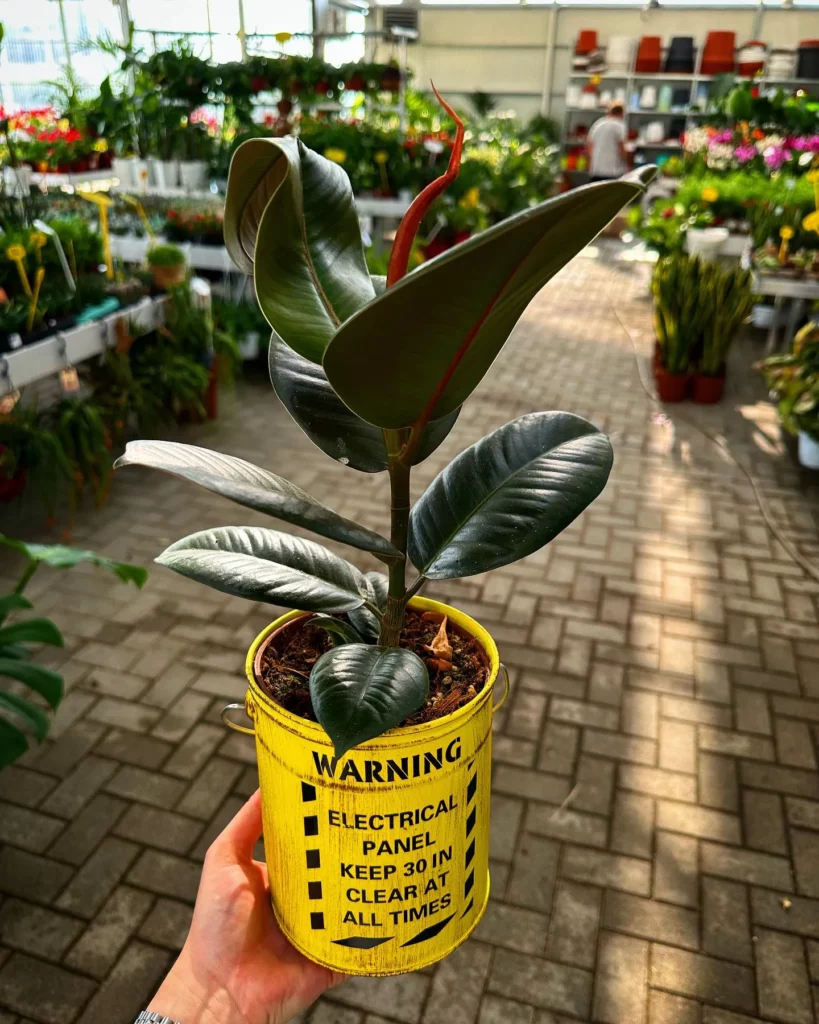
If you’re interested in expanding your Ficus elastica (‘Robusta’) collection or sharing the joy of this plant with others, propagation is a great way to achieve that. There are two popular methods when it comes to propagating Ficus elastica: stem cuttings and air layering.
Stem Cuttings
Stem cuttings are a simple and effective way to propagate Ficus elastica. Here’s how to do it:
- Select a healthy stem from the parent plant and make a clean cut using a sharp, sterilized knife or shears. The cutting should be around 6-8 inches long and have at least two nodes.
- Remove the lower leaves from the cutting, leaving only a few at the top.
- Dip the cut end of the stem into a rooting hormone to encourage root development.
- Plant the cutting in a pot filled with a well-draining soil mix. Make sure to keep the soil moist, but not waterlogged.
- Place the pot in a warm and bright location, but avoid direct sunlight.
- After a few weeks, roots should start to form. Once the new plant has established a good root system, you can transplant it into a larger pot.
No products found.
Air Layering
Air layering is another effective method for propagating Ficus elastica. Here’s how to do it:
- Identify a healthy section of the parent plant’s stem, preferably one that is flexible and easily bendable.
- Make a small incision in the stem, about halfway through the thickness.
- Using a toothpick or a small piece of wood, insert it into the incision to keep it open.
- Wrap the incision with moist sphagnum moss or a damp paper towel, ensuring that it stays in place.
- Cover the moss or towel with plastic wrap to create a humid environment.
- Secure the plastic wrap with twine or a rubber band, making sure it is tightly sealed.
- After a few weeks, roots should start to form. Once the roots are well-developed, cut the stem below the new roots and plant the cutting in a pot with well-draining soil.
| Method | Advantages | Disadvantages |
|---|---|---|
| Stem Cuttings | Easy to do, quicker results | Success rate may vary, not suitable for all stem types |
| Air Layering | Higher success rate, able to produce larger plants | Requires more time and effort, not suitable for all plants |
Quick Care Overview for Ficus elastica (‘Robusta’)



To help you keep your Ficus elastica (‘Robusta’) thriving, here’s a quick care overview that covers the essential needs of this remarkable plant.
| Care Needs | Requirements |
|---|---|
| Light | Bright indirect light, 6-8 hours daily |
| Watering | Every 1-2 weeks, allowing soil to dry out between waterings |
| Humidity | Moderate to high, mist leaves regularly |
| Temperature | 65°F to 85°F, avoid extreme temperature changes |
| Repotting | In spring, when roots outgrow pot |
| Fertilizing | Once a month in spring and summer with liquid fertilizer |
Light Requirements for Ficus elastica (‘Robusta’)
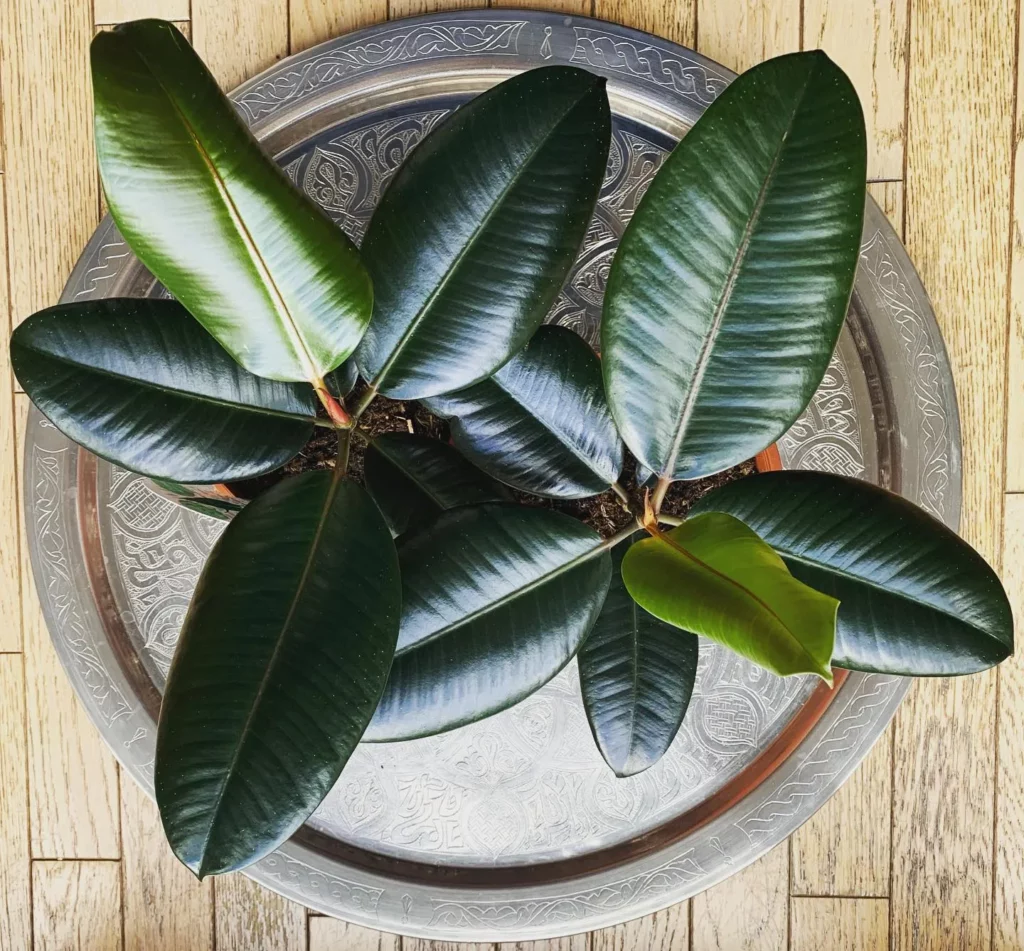
Adequate light is crucial for the healthy development of your Ficus elastica (‘Robusta’). This stunning plant thrives in bright, indirect light, making it perfect for indoor spaces. Ideally, your rubber tree should receive at least six to eight hours of light daily.
Place it near a north or east-facing window to ensure it gets the right amount of sunlight without being exposed to direct rays that could scorch its leaves.
If you don’t have a suitable window location, you can still provide sufficient light by using artificial lighting such as fluorescent or LED grow lights. These lights should be positioned approximately 12 inches above the plant’s foliage and be left on for 12 to 14 hours each day. This will simulate the natural light cycle and support the rubber tree’s growth.
| Light Requirement | Ideal Condition |
|---|---|
| Exposure | Bright, indirect light |
| Duration | 6 to 8 hours daily |
| Artificial Lighting | 12 to 14 hours daily, positioned 12 inches above foliage |
Additional Tips for Light Requirements:
- Keep your Ficus elastica (‘Robusta’) away from drafty areas, as it is sensitive to temperature fluctuations and cold air.
- Avoid placing the plant near radiators or heat sources that could cause excessive drying of the leaves.
- If you notice the leaves turning yellow or dropping, it may indicate that the plant is receiving too much direct sunlight. Move it to a slightly shadier spot.
Soil Requirements for Ficus elastica (‘Robusta’)

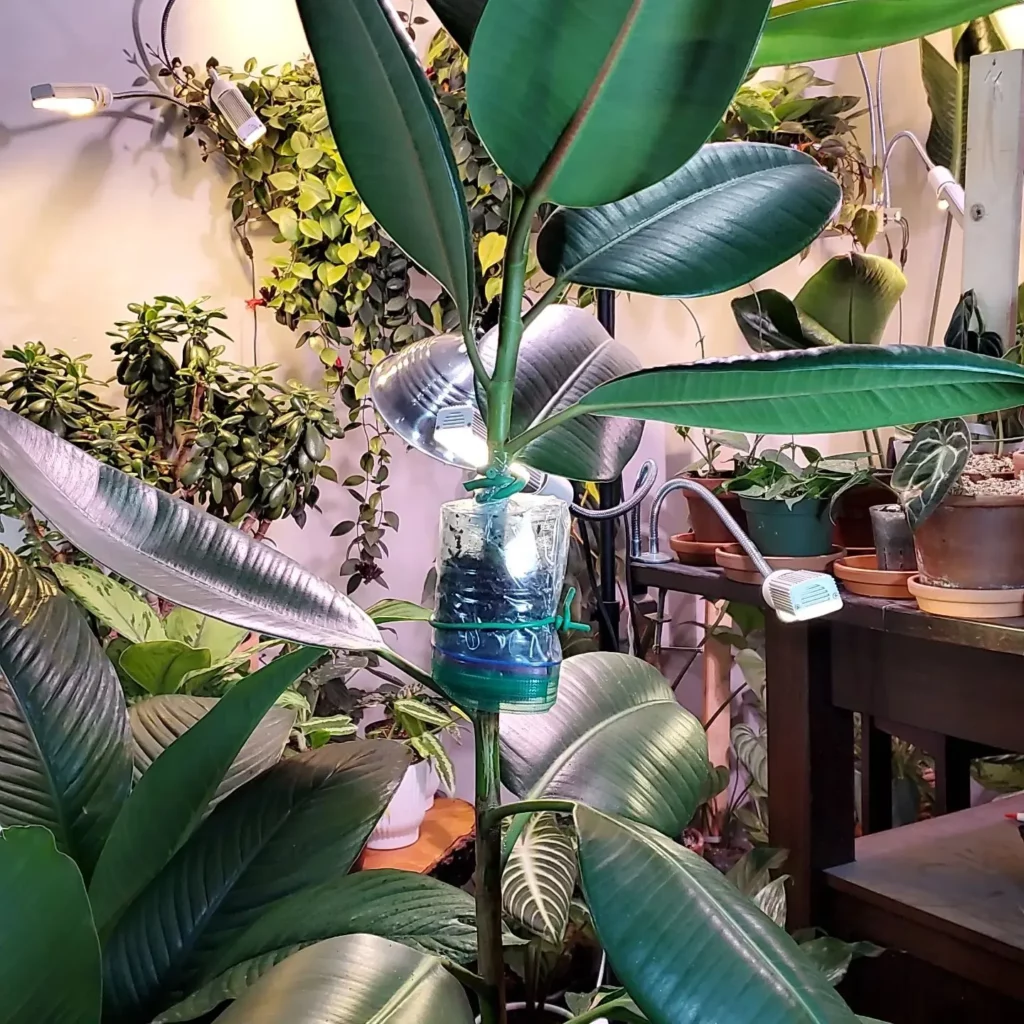

The right soil composition is essential for the overall well-being of your Ficus elastica (‘Robusta’). This tropical plant thrives in well-draining soil that retains some moisture without becoming waterlogged.
A rich and loamy potting mix is recommended, consisting of a combination of peat moss, perlite, and sand. This mixture promotes good drainage and aeration, preventing the roots from becoming waterlogged and susceptible to root rot.
To ensure proper soil moisture levels, it’s important to choose a pot with drainage holes. This allows excess water to escape, preventing water stagnation that can harm the plant. When repotting, select a pot that is slightly larger than the current one to accommodate the expanding root system. Avoid using pots that are too large, as excessive soil moisture can lead to root rot.
Avoid using heavy or clay-based soil, as it tends to retain too much moisture and can suffocate the roots. Additionally, using garden soil is not recommended, as it lacks the necessary drainage and aeration properties required for indoor potted plants like Ficus elastica (‘Robusta’).
| Soil Type | Characteristics |
|---|---|
| Well-draining potting soil | Rich, loamy, and retains some moisture without waterlogging |
| Peat moss | Helps retain moisture and improves soil texture |
| Perlite | Enhances drainage and aeration |
| Sand | Improves drainage and prevents compaction |
Potting and Repotting Ficus elastica (‘Robusta’)

Proper potting and repotting techniques are vital for maintaining the health and vitality of your Ficus elastica (‘Robusta’). When potting your rubber tree, choose a container that is slightly larger than the current pot, allowing room for the roots to grow. Opt for a well-draining potting mix, as excessive moisture can lead to root rot. Fill the bottom of the new pot with fresh potting mix, creating a mound in the center.
Gently remove the rubber tree from its current pot, being careful not to damage the roots. Inspect the roots for any signs of rot or disease, and trim away any damaged or overcrowded roots. Place the rubber tree in the center of the new pot and fill the remaining space with fresh potting mix, making sure to cover the roots completely. Press the soil gently to secure the plant in its new pot.
Repotting Frequency:
- Young Ficus elastica (‘Robusta’) plants should be repotted every 1-2 years to facilitate growth and provide fresh nutrients.
- For mature rubber trees, repotting can be done every 3-4 years to refresh the soil and give the roots more space.
After repotting, water the plant thoroughly to help settle the soil around the roots. Place the Ficus elastica (‘Robusta’) in bright, indirect light and monitor its watering needs. As a general rule, water the plant only when the top inch of soil feels dry.
Avoid overwatering, as this can lead to root rot. With proper potting and repotting techniques, your Ficus elastica (‘Robusta’) will thrive and bring beauty to your indoor space.
| Important Points | Details |
|---|---|
| Light Requirements | The rubber tree needs at least six to eight hours of light daily, preferably bright indirect light. |
| Watering | Water the plant every 1-2 weeks, allowing the soil to dry out between waterings. |
| Humidity | The plant can tolerate any level of humidity. |
| Temperature | The optimum temperature for the rubber tree is 65°F to 85°F, and it should not go below 60°F. |
| Height | The rubber plant can reach a height of about 30 ft. outdoors and 6 to 10 ft. indoors. |
| Pests | Protect the rubber tree from pests, such as spider mites and scale insects. |
| Toxicity | The rubber plant is not safe for pets or humans if consumed. |
| Fertilizing | Fertilize with a balanced liquid fertilizer once a month in spring and summer. |
Pruning and Shaping Ficus elastica (‘Robusta’)
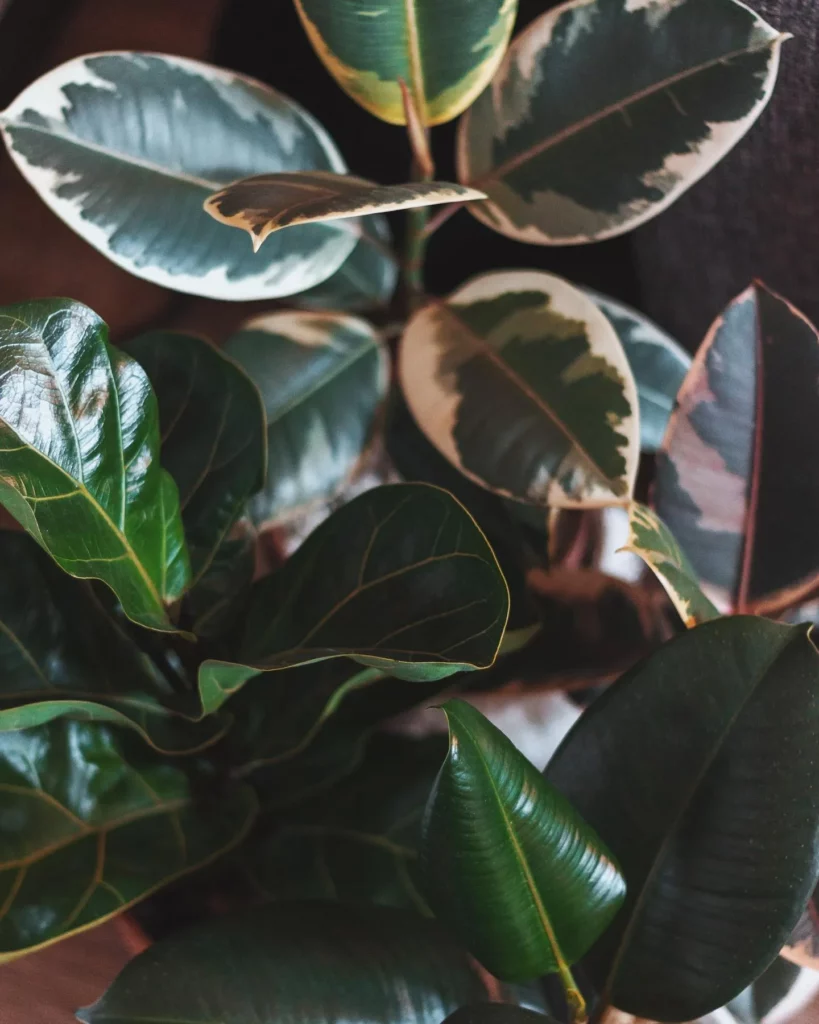
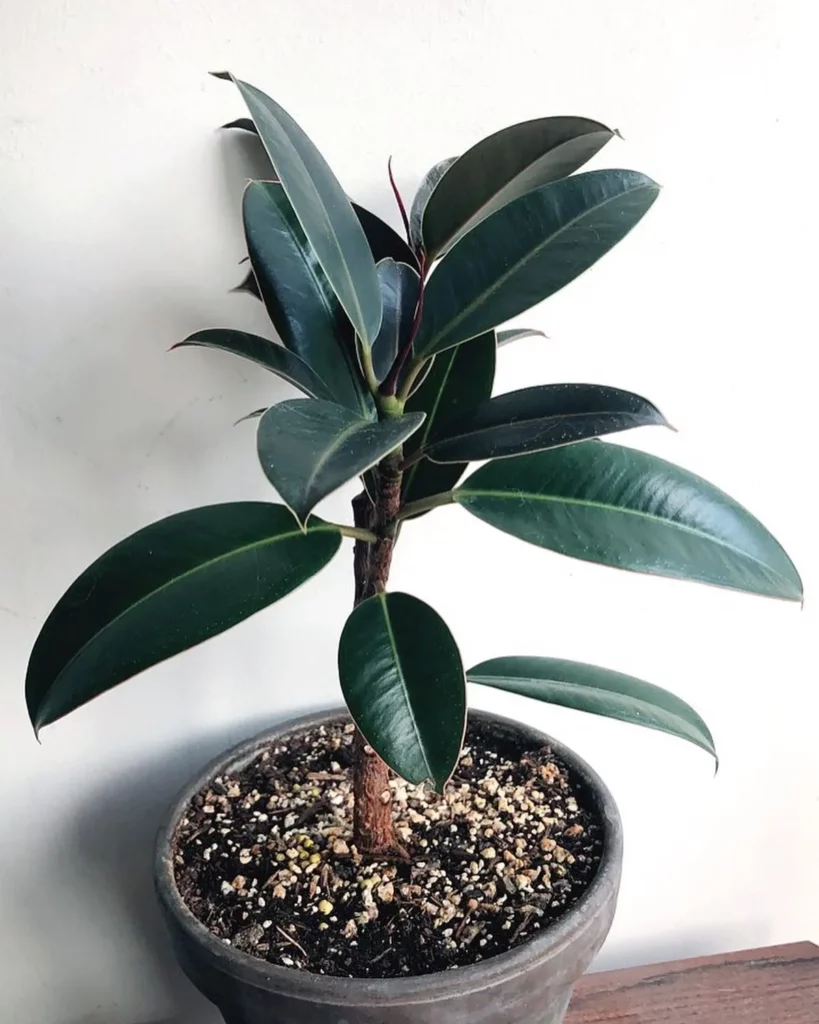
Pruning and shaping your Ficus elastica (‘Robusta’) is not only aesthetically pleasing but also necessary for its overall well-being. By removing dead or damaged leaves, you can improve the plant’s appearance and promote new growth.
Regular pruning also helps maintain a compact shape, preventing the rubber tree from becoming leggy or overgrown. To get started, gather a pair of clean, sharp pruning shears and follow these best practices:
- Remove dead or yellowing leaves: Look for any leaves that appear unhealthy or discolored and carefully trim them off at the base. This helps maintain the plant’s overall health and aesthetics.
- Control the height and shape: If your Ficus elastica (‘Robusta’) is growing too tall or spreading out in undesirable directions, you can prune the stems back to your desired height or shape. Make clean cuts just above a leaf node or bud to encourage new growth.
- Trim for thickness: Pruning back the branches can help create a fuller, bushier appearance. Focus on cutting back the longer branches to promote branching and fill in any sparse areas.
Pruning and Shaping Tips:
| Aspect | Best Practices |
|---|---|
| Pruning Tools | Use clean and sharp pruning shears |
| Timing | Prune during the active growing season (spring and summer) |
| Dead or yellowing leaves | Remove by cutting at the base |
| Height and shape control | Trim stems just above leaf nodes or buds |
| Thickening | Focus on cutting back longer branches |
| Safety precautions | Wear gloves and wash hands after handling the plant |
Temperature Requirements for Ficus elastica (‘Robusta’)
Maintaining the right temperature is essential for the optimal health and growth of your Ficus elastica (‘Robusta’). This resilient plant thrives in temperatures between 65°F and 85°F, making it well-suited for indoor environments. Avoid exposing your rubber tree to temperatures below 60°F, as it may lead to leaf drop and hinder its overall development.
When positioning your Ficus elastica (‘Robusta’) indoors, choose a location where it can benefit from indirect sunlight and a consistent temperature. Keep in mind that sudden temperature fluctuations, such as placing the plant near drafts or air conditioning vents, can negatively impact its growth.
If you live in a region with harsh winters, take extra precautions to prevent your rubber tree from being exposed to cold drafts or frost. Consider moving it away from windows during winter months or providing additional insulation to protect it from extreme temperature changes.
| Temperature | Best for Ficus elastica (‘Robusta’) |
|---|---|
| 65°F – 85°F | Optimal temperature range for growth |
| Below 60°F | Avoid exposing the plant to these temperatures |
Quick Tips:
- Place your Ficus elastica (‘Robusta’) in a room with consistent temperatures and avoid exposing it to cold drafts or extreme heat.
- Monitor the temperature around your plant using a thermometer to ensure it remains within the optimal range.
- Consider using a humidifier during the winter months to maintain a suitable level of humidity, as well as temperature, for your rubber tree.
“Maintaining the right temperature is crucial for the overall well-being of your Ficus elastica (‘Robusta’). Avoid exposing it to extreme temperatures and provide a stable environment for optimal growth.”
Humidity Requirements for Ficus elastica (‘Robusta’)
While Ficus elastica (‘Robusta’) can tolerate any level of humidity, providing the right moisture levels can greatly enhance its well-being. This tropical plant thrives in environments with higher humidity, which mimics its natural habitat.
To create the ideal humidity conditions for your Ficus elastica (‘Robusta’), consider the following tips:
- Place your Ficus elastica (‘Robusta’) near a humidifier or mist the leaves regularly. This will help increase the moisture in the air surrounding the plant.
- Grouping your Ficus elastica (‘Robusta’) with other plants can create a microclimate that retains moisture, benefiting all the plants involved.
- Avoid placing your Ficus elastica (‘Robusta’) near heating vents or drafty areas, as these can cause dry air that may lead to dehydration.
Monitoring the humidity levels in your home is essential to ensure your Ficus elastica (‘Robusta’) remains healthy. You can use a hygrometer to measure the humidity levels and make adjustments accordingly. If the humidity drops below 40%, consider implementing the above methods to increase moisture around your plant.
The Benefits of Adequate Humidity
“Maintaining proper humidity levels for your Ficus elastica (‘Robusta’) can have numerous benefits. It not only helps prevent the browning of leaf edges, but it can also deter pest infestations, enhance leaf coloration, and promote overall growth and vitality.”
Providing adequate humidity levels for your Ficus elastica (‘Robusta’) is an important aspect of its care. By ensuring the right moisture balance, you can create an environment that promotes the plant’s well-being and helps it thrive.
| Temperature Range | Ideal Humidity Levels |
|---|---|
| 65°F to 75°F | 40% to 60% |
| 75°F to 85°F | 50% to 70% |
Watering Ficus elastica (‘Robusta’)
Proper watering is crucial for the health and vitality of your Ficus elastica (‘Robusta’). This beautiful indoor plant requires a consistent watering routine to thrive. It’s important to strike a balance between keeping the soil moist and avoiding overwatering, which can lead to root rot and other water-related issues.
When watering your Ficus elastica (‘Robusta’), it’s essential to follow the “soak and dry” method. This means thoroughly saturating the soil until water drains out of the bottom of the pot, and then allowing the top few inches of the soil to dry out before watering again.
This approach mimics the plant’s natural habitat, ensuring proper hydration while preventing waterlogged roots.
You should aim to water your Ficus elastica (‘Robusta’) every 1-2 weeks. However, the frequency may vary depending on factors such as humidity levels, temperature, and the size of the pot.
Remember to always check the moisture level of the soil before watering to avoid overwatering. Stick your finger about an inch into the soil; if it feels dry, it’s time to water. If it still feels slightly moist, hold off for a few more days.
To create a comfortable watering routine, consider using a moisture meter or setting a reminder on your calendar. These tools can help you keep track of when it’s time to water your Ficus elastica (‘Robusta’) and ensure that you’re providing it with the proper care it needs.
Watering Tips for Ficus elastica (‘Robusta’)
| Watering Tip | Explanation |
|---|---|
| Use well-draining soil | Ficus elastica (‘Robusta’) prefers soil that allows excess water to flow freely, preventing waterlogged roots. |
| Water thoroughly | Ensure that water reaches the bottom of the pot to promote deep root growth. |
| Avoid standing water | Remove any excess water in the saucer or tray to prevent rot and fungal growth. |
| Monitor humidity levels | High humidity can prolong the drying time of the soil, so adjust your watering schedule accordingly. |
Fertilizing Ficus elastica (‘Robusta’)
Fertilizing your Ficus elastica (‘Robusta’) is key to ensuring it receives the necessary nutrients for vigorous growth. This tropical plant has a high nutrient requirement, and regular fertilization will help maintain its health and beauty. By providing the right balance of nutrients, you can promote strong root development, lush foliage, and overall plant vitality.
Choosing the Right Fertilizer
When it comes to fertilizing Ficus elastica (‘Robusta’), it is important to choose the right type of fertilizer. Look for a balanced, water-soluble fertilizer specifically formulated for indoor plants.
These fertilizers are typically labeled with an N-P-K ratio, indicating the percentage of nitrogen (N), phosphorus (P), and potassium (K) they contain. For Ficus elastica (‘Robusta’), a balanced ratio such as 10-10-10 or 20-20-20 is recommended. Additionally, opt for a slow-release fertilizer that will provide a constant supply of nutrients over time.
It is important to follow the manufacturer’s instructions when applying fertilizer to your Ficus elastica (‘Robusta’). Overfertilizing can lead to nutrient burn and damage to the plant’s roots, while underfertilizing can result in stunted growth and nutrient deficiencies. Always dilute the fertilizer according to the instructions and apply it to moist soil to prevent root damage.
Fertilizing Frequency
During the active growing season, which typically occurs in spring and summer, it is recommended to fertilize your Ficus elastica (‘Robusta’) every two to four weeks. This will provide a steady supply of nutrients to support its growth and development. In fall and winter, when the plant is dormant, reduce the frequency to once every six to eight weeks.
Additional Care Tips
While fertilization is an important aspect of caring for your Ficus elastica (‘Robusta’), it should be complemented with proper watering, light exposure, and overall maintenance. Ensure the soil is well-draining to prevent waterlogged conditions, as this can hinder nutrient uptake.
Place your plant in a location that provides bright, indirect light for at least six to eight hours a day. Regularly dust the leaves with a damp cloth to keep them clean and free from dust buildup, allowing the plant to efficiently photosynthesize.
| Fertilizing Tips for Ficus elastica (‘Robusta’) |
|---|
| Choose a balanced, water-soluble fertilizer specifically formulated for indoor plants. |
| Look for a slow-release fertilizer for a continuous nutrient supply. |
| Follow the manufacturer’s instructions for dilution and application. |
| Fertilize every two to four weeks during the active growing season. |
| Reduce frequency to once every six to eight weeks in fall and winter. |
| Monitor for signs of nutrient deficiencies or excesses and adjust fertilizing accordingly. |
Pest Control for Ficus elastica (‘Robusta’)
Protecting your Ficus elastica (‘Robusta’) from pests is essential for maintaining its health and vitality. Common pests that may affect your rubber tree include mealybugs, spider mites, and scale insects. Here’s a guide to identifying, preventing, and controlling these pests to ensure your Ficus elastica stays in optimal condition.
Mealybugs:
Mealybugs are small white insects that suck sap from plant leaves and stems, causing yellowing, wilting, and stunted growth. To treat a mealybug infestation, start by isolating the affected plant from other houseplants to prevent the spread of pests.
Use a cotton swab dipped in rubbing alcohol to dab and remove the pests. Alternatively, you can use a gentle insecticidal soap or Neem oil spray to control the infestation. Repeat the treatment every week until all mealybugs are eliminated.
Spider Mites:
Spider mites are tiny pests that can be identified by their fine webbing and speckled leaves. They feed on the plant’s sap, causing yellowing, leaf drop, and fine webbing on the leaves. To control spider mites, regularly mist the leaves to increase humidity, as these pests thrive in dry conditions.
You can also use a water spray to dislodge them from the plant. Introducing natural predators like ladybugs can also help keep spider mite populations in check. If the infestation persists, consider using a horticultural oil or insecticidal soap, following the product instructions carefully.
Scale Insects:
Scale insects are small, oval-shaped pests that attach themselves to the plant’s stems and leaves, feeding on sap. They can be identified by their brown or black shell-like covering. To control scale insects, start by removing them manually using a cotton swab dipped in rubbing alcohol or by gently scraping them off with your fingernail.
Ensure that you reach all parts of the plant, including the undersides of leaves and stems. You can also use a horticultural oil spray to suffocate and control scale insects. Regularly check your Ficus elastica for signs of reinfestation and repeat treatments as necessary.
| Pest | Identification | Control |
|---|---|---|
| Mealybugs | Small white insects with a cotton-like appearance | – Isolate affected plant – Use rubbing alcohol, insecticidal soap, or Neem oil spray – Repeat treatment weekly |
| Spider Mites | Fine webbing, speckled leaves | – Increase humidity – Use water spray to dislodge pests – Introduce natural predators – Consider horticultural oil or insecticidal soap |
| Scale Insects | Brown or black shell-like covering | – Remove manually with rubbing alcohol or scraping – Use horticultural oil spray – Regularly check for reinfestation |
Common Problems with Ficus elastica (‘Robusta’)
While Ficus elastica (‘Robusta’) is generally an easy plant to care for, it can face certain challenges that require attention and proper care. Being aware of the common problems that can occur will help you provide the necessary remedies and ensure the health and longevity of your rubber tree.
One common issue with Ficus elastica is leaf drop. This can be caused by various factors, including overwatering, underwatering, sudden temperature changes, or inadequate light.
To prevent leaf drop, make sure to water your plant appropriately – allowing the soil to dry out between waterings. Additionally, ensure that your Ficus elastica is placed in a spot with sufficient light and avoid exposing it to drafts or extreme temperature fluctuations.
Fungal diseases, such as leaf spots or powdery mildew, can also affect Ficus elastica. These diseases are often caused by overwatering or high humidity levels. To prevent fungal problems, avoid overwatering and ensure your plant is not sitting in water. Adequate air circulation around the plant can also help prevent the development of fungal diseases.
Another challenge you may encounter is pest infestations. Common pests that can affect Ficus elastica include spider mites, mealybugs, and scale insects. These pests can cause damage to the leaves and weaken the overall health of the plant.
To control pest infestations, regularly inspect your rubber tree for any signs of pests and take appropriate measures, such as using insecticidal soap or neem oil. Isolating the affected plant from other plants can also prevent the spread of pests.
| Common Problems | Possible Causes | Prevention/Remedy |
|---|---|---|
| Leaf drop | Overwatering, underwatering, temperature fluctuations, inadequate light | Proper watering, correct lighting conditions, temperature control |
| Fungal diseases | Overwatering, high humidity | Avoid overwatering, ensure good air circulation |
| Pest infestations | Spider mites, mealybugs, scale insects | Regular inspections, use of insecticidal soap or neem oil |
Conclusion
By following the guidelines outlined in this Ultimate Ficus elastica (‘Robusta’) Care Guide, you’ll be well-equipped to nurture and enjoy the beauty of this remarkable plant.
Ficus elastica (‘Robusta’), also known as the rubber tree, is an excellent choice for indoor plant enthusiasts due to its unique qualities and benefits. This resilient plant can reach heights of about 30 ft. outdoors and 6 to 10 ft. indoors, making it a stunning addition to any space.
When caring for Ficus elastica (‘Robusta’), it’s important to ensure it receives at least six to eight hours of light daily, preferably bright indirect light. Watering should be done every 1-2 weeks, allowing the soil to dry out between waterings to prevent overwatering.
The rubber tree can tolerate any level of humidity, making it adaptable to various indoor environments.
The optimum temperature range for Ficus elastica (‘Robusta’) is between 65°F and 85°F, with a minimum temperature of 60°F. To promote optimal growth and enhance its appearance, repotting should be done in the spring when the roots outgrow the pot.
Additionally, wiping the leaves clean ensures the pores can breathe, contributing to the plant’s overall health.
Lastly, protecting Ficus elastica (‘Robusta’) from pests is crucial. Regular monitoring and prompt action can prevent infestations and maintain the plant’s vitality. It’s worth noting that the rubber plant is toxic to pets and humans if consumed, so it should be kept out of reach.
With consistent care and attention, your Ficus elastica (‘Robusta’) will thrive and become a focal point of natural beauty in your home. Enjoy the journey of nurturing this remarkable plant and reaping the rewards of its stunning presence.
Make sure to check out our article on Ficus elastica Rubber Plant Care Guide. And after reading that Ficus article, check out our Ficus elastica Tineke Care Guide.
FAQ
Q: How often should I water my Ficus elastica (‘Robusta’)?
A: Water your Ficus elastica (‘Robusta’) every 1-2 weeks, allowing the soil to dry out between waterings.
Q: What is the ideal light requirement for Ficus elastica (‘Robusta’)?
A: Ficus elastica (‘Robusta’) needs at least six to eight hours of light daily, preferably bright indirect light.
Q: Can Ficus elastica (‘Robusta’) tolerate any level of humidity?
A: Yes, Ficus elastica (‘Robusta’) can tolerate any level of humidity.
Q: What is the optimum temperature range for Ficus elastica (‘Robusta’)?
A: The optimum temperature for Ficus elastica (‘Robusta’) is 65°F to 85°F and it should not go below 60°F.
Q: How tall can Ficus elastica (‘Robusta’) grow?
A: Ficus elastica (‘Robusta’) can reach a height of about 30 ft. outdoors and 6 to 10 ft. indoors.
Q: Is Ficus elastica (‘Robusta’) safe for pets or humans if consumed?
A: No, Ficus elastica (‘Robusta’) is not safe for pets or humans if consumed.
Q: When should I repot my Ficus elastica (‘Robusta’)?
A: Repot your Ficus elastica (‘Robusta’) in the spring when the roots outgrow the pot.
Q: How should I care for the rubber tree to protect it from pests?
A: Wipe the rubber tree clean to allow the pores to breathe and take precautions to protect it from pests.
Q: Can I fertilize my Ficus elastica (‘Robusta’)?
A: Yes, you can fertilize your Ficus elastica (‘Robusta’) with liquid fertilizer once a month in spring and summer.





